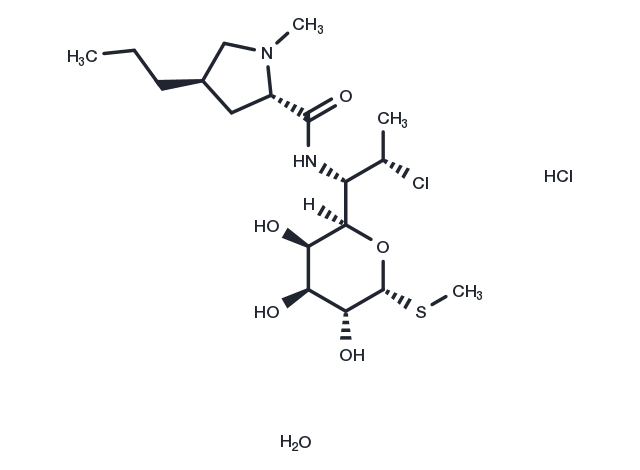Powder: -20°C for 3 years | In solvent: -80°C for 1 year


Clindamycin hydrochloride monohydrate (Clindamycin alcoholate) is a protein synthesis inhibitor used orally, capable of diminishing virulence factor expression in Staphylococcus aureus at sub-minimum inhibitory concentrations (sub-MICs). It acts by suppressing Panton-Valentine leucocidin (PVL), toxic-shock-staphylococcal toxin (TSST-1), and alpha-haemolysin (Hla) production. Resistance to this compound emerges through enzymatic methylation at the antibiotic's 50S ribosomal subunit binding site (23S rRNA).

| Pack Size | Availability | Price/USD | Quantity |
|---|---|---|---|
| 100 mg | In stock | $ 53.00 |

| Description | Clindamycin hydrochloride monohydrate (Clindamycin alcoholate) is a protein synthesis inhibitor used orally, capable of diminishing virulence factor expression in Staphylococcus aureus at sub-minimum inhibitory concentrations (sub-MICs). It acts by suppressing Panton-Valentine leucocidin (PVL), toxic-shock-staphylococcal toxin (TSST-1), and alpha-haemolysin (Hla) production. Resistance to this compound emerges through enzymatic methylation at the antibiotic's 50S ribosomal subunit binding site (23S rRNA). |
| Synonyms | Clindamycin alcoholate |
| Molecular Weight | 479.46 |
| Formula | C18H36Cl2N2O6S |
| CAS No. | 58207-19-5 |
Powder: -20°C for 3 years | In solvent: -80°C for 1 year
DMSO: 90mg/mL (187.7mM)
You can also refer to dose conversion for different animals. More
bottom
Please see Inhibitor Handling Instructions for more frequently ask questions. Topics include: how to prepare stock solutions, how to store products, and cautions on cell-based assays & animal experiments, etc.
Clindamycin hydrochloride monohydrate 58207-19-5 Microbiology/Virology Antibiotic Clindamycin hydrochloride Monohydrate Clindamycin alcoholate Clindamycin Hydrochloride inhibitor inhibit
